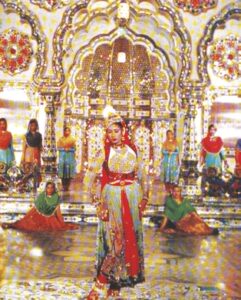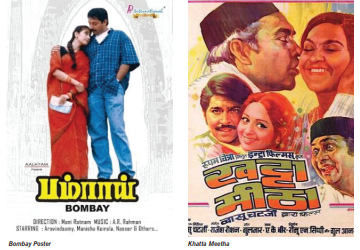Early mainstream Bollywood hardly touched upon communal conflicts. Filmmakers were afraid that portrayal of such sensitive issues would raise the hackles of the Central Board for Film Certification. This absence of violence between communities also reflects the secular sensibilities of people within Bollywood, opines Shoma A. Chatterji.
“A deep structure of cultural difference provides the bedrock of perceptions, one coloured by Hindu and more broadly modern modes of othering” wrote Ravi S. Vasudevan of Mani Ratnam’s Bombay made after the communal riots in Mumbai following the demolition of the Babri Masjid in Ayodhya. ‘Cultural difference’ is no longer a moot question after the 9/11 tragedy of the twin towers of WTC. It has enlarged and reached out to the world where destruction, willful, designed violence, mass killings triggered by fundamentalist beliefs that have no basis in scriptures or in the foundations of a religion, take place every day, everywhere for no understandable reason. Will Hindi cinema be able to repair the damage and restore to the celluloid Muslim and to his real-life counterpart the dignity he/she deserves?
Seemin Hasan who taught English at Aligarh Muslim University, once said, “The projection of Muslims as uneducated, misguided and ruthless communalists reflects anxieties. Such images (beginning with Wasim Khan’s character in Mani Ratnam’s Roja as an example) as uneducated, misguided and ruthless communalists reflects anxieties. Such images are also projected in films like L.O.C. Kargil (2003) and Mission Kashmir (2000.) The Muslim identity is trapped in the image of the terrorist. The last decade of the 20th century signals an important departure as a new stereotype of the Muslim is born – as a ruthless stranger with an anti-nationalist agenda.”

Hrishikesh Mukherjee’s Anari (1959) is a unique example of a beautiful relationship between Raj Kumar (Raj Kapoor) the hero and his landlady who he nurses and looks after in her dying days. Today, we see Christians and Anglo-Indians no longer as cameo performers but as characters in a film set within their ethnic backdrop. Two examples are Sanjay Leela Bhansali’s Black (2005) and Guzaarish (2010). Guzaarish is said to be a celluloid improvisation of a real life, wheelchair-bound paraplegic, Ethan Mascarenhas in the film portrayed by Hrithik Roshan. These films are set within the Christian ethos. Black is set in Shimla and revolves around the lives of the McNallys. But Devraj Sahai, the alcoholic recluse who steps into the family in Black is Hindu.
Basu Chatterjee presented entertainment through single ethnic groups in Khatta Meetha (1977) and Baaton Baaton Mein (1979.) Khatta Meetha portrayed the Parsee community very well through two families joined in marriage with grown-up children coping with the sudden change through the sudden crash that overtakes them. Baaton Baaton Mein deals with the problem of a girl earning more than her would-be spouse within a Christian setting. The films explored middle class values with simple characters and a straightforward narrative embellished with beautiful songs. Being Cyrus (2006) directed by Homi Adajania however, portrays the Parsees as dysfunctional, shrewish, villainous, alcoholic or crazy. It was promoted as a psychological murder mystery but its totally negative connotations did not do any good to the representation of the Parsee in Indian cinema. A wonderful cocktail of several ethnic Indian groups presented in recent times is Rima Kagti’s Honeymoon Special Private Limited.
Sikhs have been represented mainly through and in historical fiction films such as the Shaheed Bhagat Singh series and, Gadar, where a single Sikh takes on the entire Pakistani army. Sunny Deol and Dharmendra should be credited for keeping the Sikh flag aloft while Akshay Kumar has paid an entertaining tribute to the Sikhs in Singh is King (2008) where every male character is a turbaned Sikh.
Early mainstream Bollywood hardly touched upon communal conflicts. Filmmakers were afraid that sensitive issues like communal conflicts would raise the hackles of the Central Board for Film Certification. This absence of violence between communities also reflects the secular sensibilities of people within Bollywood, where marriages between different communities are as much an integral part of real life as it is a part of the work structure and the system. Harmony remained the bottom line so far as communalism between and among people was concerned.
Earlier films like V. Shantaram’s Padosi (Shejari in Marathi) focused on a harmonious relationship between two neighbours, one a Hindu and the other, a Muslim. The religious minority in India was often portrayed as a token presence with positive shades, introduced as an important character in the script. Significant among these are – the Muslim who brings up the illegitimate boy in B.R. Chopra’s Dhool Ka Phool (1960) and the Muslim taxi driver in Vijay Anand’s Guide. A Muslim social which spoke of romance and heartbreak such as Chaudhavin Ka Chand, Barsaat Ki Raat, Ghazal, Mere Mehboob, Pakeezah, etc. or historicals like Mughal-e-Azam, Jodha-Akbar, Anarkali and Mirza Ghalib did not threaten the status quo. A film which spoke of change did. A classic example is the controversy Mani Ratnam’s Bombay raised. There was a beautiful moment in Bombay. When the twins of the intercommunal couple get lost in the communal riots, they are given shelter and rescued by a hermaphrodite, a hijra who has no caste identity.
The positive and often romantic portrayal of non-Hindu religious minorities in Indian films is a prime reason for their international popularity. Bollywood has shown the world how people of different faiths join joyfully in each other’s festivals, lay down their lives protecting each other and share in each other’s joys, griefs and family secrets. The theme song of the film Dhool ka Phool made in the late 1950s: Tu Hindu banega naa Musalman banega, insaan ki aulad hai, insaan banega (You will grow up to be neither Hindu nor Musalman, you are the child of a human being and will remain a human being), echoes the sentiment of bhakt Kabir. This sentiment has been repeated in film after film, strengthening the message that all are sons and daughters of Mother India and are therefore inseparable, no matter how hard the politicians try to break their unity and sense of oneness.


 Shoma A. Chatterji is a freelance journalist, film scholar and author. She has authored 17 published titles and won the National Award for Best Writing on Cinema, twice. She won the UNFPA-Laadli Media Award, 2010 for ‘commitment to addressing and analysing gender issues’ among many awards.
Shoma A. Chatterji is a freelance journalist, film scholar and author. She has authored 17 published titles and won the National Award for Best Writing on Cinema, twice. She won the UNFPA-Laadli Media Award, 2010 for ‘commitment to addressing and analysing gender issues’ among many awards.